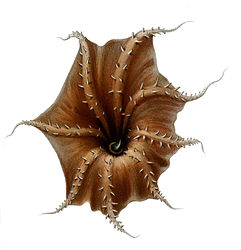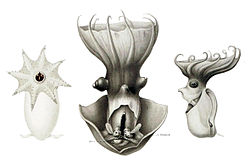Vampire squid
| Vampire squid | ||||||||||||
|---|---|---|---|---|---|---|---|---|---|---|---|---|

Vampire squid ( Vampyroteuthis infernalis ) |
||||||||||||
| Systematics | ||||||||||||
|
||||||||||||
| Scientific name of the family | ||||||||||||
| Vampyroteuthidae | ||||||||||||
| Thiele , in Chun, 1915 | ||||||||||||
| Scientific name of the genus | ||||||||||||
| Vampyroteuthis | ||||||||||||
| Chun , 1903 | ||||||||||||
| Scientific name of the species | ||||||||||||
| Vampyroteuthis infernalis | ||||||||||||
| Chun , 1903 |
The vampire squid ( Vampyroteuthis infernalis ) was discovered during the first German deep-sea expedition 1898–1899 and is the only representative of the order of the vampyromorpha to be a phylogenetic transition form from ten to eight-armed cephalopods. Its name, which literally means "vampire squid from hell", is due to the skins that stretch between its arms and give it the appearance of a vampire wrapped in a cloak . Contrary to its name, the vampire squid does not feed on blood , but on detritus .
discovery
The vampire squid was discovered during the first German deep-sea expedition from 1898 to 1899 and was first scientifically described in 1903 by the German Carl Chun .
anatomy
With a body length of up to 30 cm, the vampire squid is one of the smaller representatives of the cephalopods and eight-armed squids . The suction cups on the arms are not used to hold the prey, as is the case with other squids, but to glue in detritus . These eight envelope arms are provided with finger-like appendages that propel the food slime.
In addition to these eight arms for gluing in, there are also two other thread- shaped arms provided with sensory organs , which are used for palpation , and possibly also for smelling detritus. These thread-like arms can be stretched to eight times the length of the torso, as well as pulled back into the coat.
It has pronounced fins on the back of the coat . The body is occupied by numerous luminous organs that generate light by means of bioluminescence . A pair of these luminous organs can be closed by special eyelids and can eject a cloud of luminous particles to confuse potential enemies. This cloud persists for up to ten minutes and glows. The eyes of the vampire squid are the largest in the animal kingdom in relation to the body and, with a width of almost two cm, make up almost one sixth of the body length.
habitat
Vampyroteuthis lives in the deep sea between 600 and 1000 meters depth, according to other sources up to 3000 meters. The optimal water temperature is between 2 and 6 ° C. During his life he stays in an oxygen-poor environment ( oxygen saturation sometimes less than 5%). Vampyroteuthis can live here because his blood contains another blood pigment ( hemocyanin ), which can very effectively bind oxygen from the water, and the surface area of his gills is very large.
Way of life
The vampire squid pursues an energy-saving lifestyle. The animal has a very low metabolic rate . Usually it lets itself be carried by the current and hardly moves actively. The large fins and the skins between the arms allow this locomotion, which is similar to that of the jellyfish . On the other hand, Vampyroteuthis is also capable of quick movements.
In contrast to all other cephalopods, the vampire squid does not prey on living animals, but feeds on organic particles that sink to the bottom in the deep sea, the so-called sea snow . This consists of diatoms , zooplankton , salps as well as eggs, larvae and body parts ( detritus ) of fish and crustaceans . The food particles are sensed with the two thread-shaped sensory arms, gummed up by the suction cups of the eight other arms, enveloped by the coat of the eight holding arms and absorbed by the mouth as a slimy mass.
literature
- Vilém Flusser , Louis Bec: Vampyroteuthis infernalis: a treatise including findings from the Institut Scientifique de Recherche Paranaturaliste , 2nd edition, Göttingen 1993, ISBN 3-923283-23-7 . (A tongue-in-cheek essayistic treatise by the literary theorist Flusser on the world experience of the vampire squid, in which he presents it as something radically opposed to human life.)
Web links
- Deep-Sea Cephalopods: Introduction and Overview in English (Kat Bolstad )
- Tree of Life: Vampyroteuthis infernalis (English)
- Light Production by the Arm Tips of Deep-Sea Cephalopod Vampyroteuthis infernalis (English)
- National Geographic: Vampire of the Deep Sea
- Science Friday: The Vampire Squid From Hell (English)
- YouTube: Video of a vampire fish (running time 1:22 min), recorded in June 2014
- GrindTV: Vampire squid spotted in Gulf of Mexico depths (video)
Individual evidence
- ↑ a b c d Hendrik JT Hoving & Bruce H. Robison: Vampire squid: detritivores in the oxygen minimum zone. Proc. R. Soc. B, doi : 10.1098 / rspb.2012.1357


